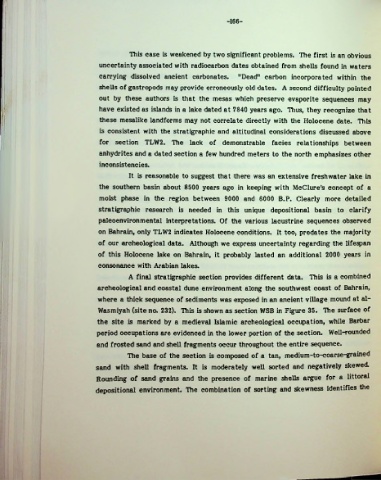Page 190 - Life & Land Use on the Bahrain Islands (Curtis E Larsen)
P. 190
-166-
This case is weakened by two significant problems. The first is an obvious
uncertainty associated with radiocarbon dates obtained from shells found in waters
carrying dissolved ancient carbonates. "Dead” carbon incorporated within the
shells of gastropods may provide erroneously old dates. A second difficulty pointed
out by these authors is that the mesas which preserve evaporite sequences may
! have existed as islands in a lake dated at 7840 years ago. Thus, they recognize that
these mesalike landforms may not correlate directly with the Holocene date. This
is consistent with the stratigraphic and altitudinal considerations discussed above
for section TLW2. The lack of demonstrable facies relationships between
anhydrites and a dated section a few hundred meters to the north emphasizes other
inconsistencies.
It is reasonable to suggest that there was an extensive freshwater lake in
the southern basin about 8500 years ago in keeping with McClureTs concept of a
moist phase in the region between 9000 and 6000 B.P. Clearly more detailed
stratigraphic research is needed in this unique depositional basin to clarify
paleoenvironmental interpretations. Of the various lacustrine sequences observed
on Bahrain, only TLW2 indicates Holocene conditions. It too, predates the majority
of our archeological data. Although we express uncertainty regarding the lifespan
of this Holocene lake on Bahrain, it probably lasted an additional 2000 years in
consonance with Arabian lakes.
A final stratigraphic section provides different data. This is a combined
archeological and coastal dune environment along the southwest coast of Bahrain,
where a thick sequence of sediments was exposed in an ancient village mound at al-
Wasmiyah (site no. 232). This is shown as section WSB in Figure 35. The surface of
the site is marked by a medieval Islamic archeological occupation, while Barbar
period occupations are evidenced in the lower portion of the section. Well-rounded
and frosted sand and shell fragments occur throughout the entire sequence.
Tlie base of the section is composed of a tan, medium-to-coarse-grained
sand with shell fragments. It is moderately well sorted and negatively skewed.
Rounding of sand grains and the presence of marine shells argue for a littoral
depositional environment. The combination of sorting and skewness identifies the

